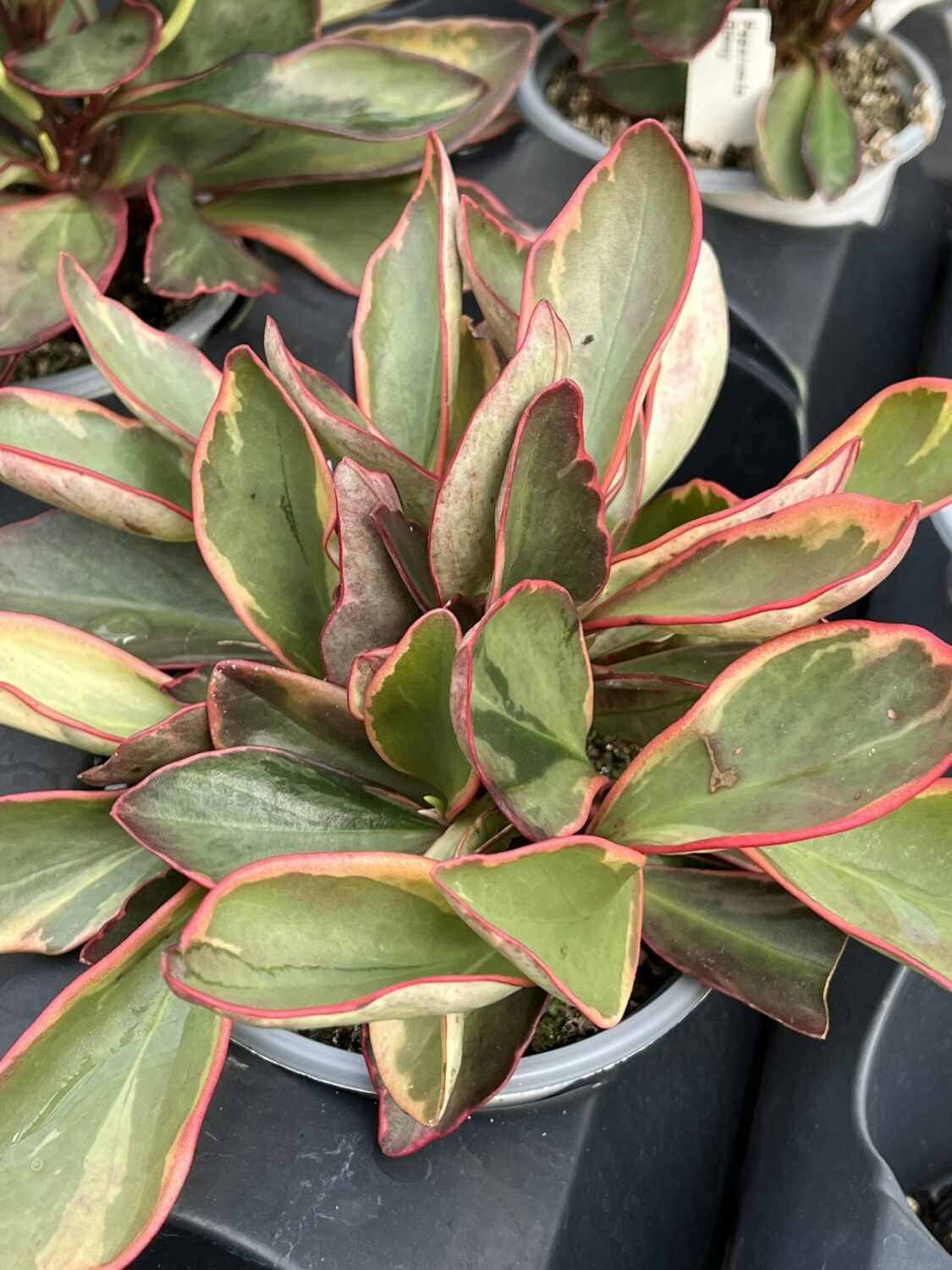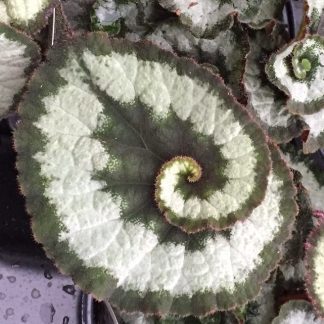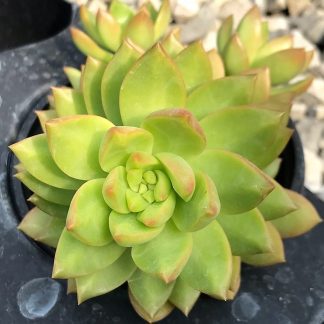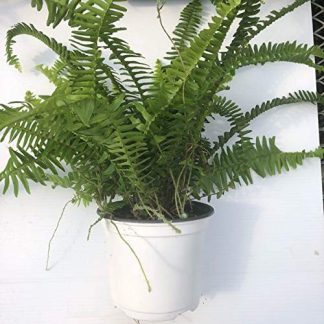Description
Peperomia clusiifolia ‘Ginny’: A Colorful, Easy-Care Houseplant
Peperomia clusiifolia ‘Ginny,’ also called the Tricolor or Rainbow Peperomia, is a showstopper. This vibrant houseplant turns heads with its soft pink edges, creamy white margins, and lush green centers. Its compact size and forgiving nature make it a favorite for beginners and seasoned plant lovers alike.
Native to the warm, tropical regions of Central and South America, ‘Ginny’ belongs to the diverse Piperaceae family. This group is known for plants with striking leaves and tidy growth habits. Among them, ‘Ginny’ stands out for its cheerful color palette and resilience indoors.
If you want a plant that adds instant charm and thrives with little fuss, Peperomia ‘Ginny’ might be exactly what your home needs.
The Standout Appeal of ‘Ginny’
What makes this plant so beloved? Its leaves. Each one is thick and waxy, storing water like a succulent. The green centers fade to creamy white, then blush pink or coral at the edges. The effect is soft but striking—a living piece of art.
‘Ginny’ stays modest in size, typically reaching 12 to 18 inches tall and about a foot wide. Its upright, bushy form works beautifully in apartments, offices, or even on a sunny kitchen windowsill. Unlike many plants that sprawl or climb, ‘Ginny’ grows neatly in place, making it easy to style in tight spaces.
Light: The Secret to Vibrant Color
Light is key to keeping those pink edges glowing. Place your Peperomia ‘Ginny’ in bright, indirect light. East- or north-facing windows are ideal. A sheer curtain can soften stronger sun from a south-facing window.
Too little light? The pink and cream colors may fade, leaving mostly green leaves. Too much direct sun? The leaves can scorch or develop dry spots.
Pro Tip: Rotate your pot every couple of weeks. This prevents the plant from leaning toward the light and keeps its shape balanced.
Watering: Less Is More
‘Ginny’ is beginner-friendly because it tolerates some neglect. Its succulent-like leaves store water, so it doesn’t need frequent watering.
-
Let the top 1–2 inches of soil dry out before watering again.
-
In spring and summer, water about every 1–2 weeks.
-
In fall and winter, cut back to once every 3–4 weeks.
Signs of Trouble:
-
Underwatered: Curling or drooping leaves.
-
Overwatered: Yellowing leaves and soggy soil.
Always err on the side of underwatering. Root rot from too much water is the biggest threat to this plant.
Humidity and Temperature Needs
This tropical beauty thrives in moderate to high humidity but adapts to average indoor conditions. It’s happiest at 50–60% humidity.
Ways to boost humidity:
-
Place the pot on a pebble tray filled with water.
-
Group it with other plants to create a mini microclimate.
-
Use a humidifier if your air is very dry, especially in winter.
Temperature-wise, aim for 65–80°F (18–27°C). Avoid cold drafts, heaters, and sudden temperature swings.
The Right Soil and Pot
‘Ginny’ loves light, airy soil that drains quickly. A basic potting mix works well, but improve it by adding:
-
Perlite for aeration.
-
Orchid bark or coarse sand for drainage.
Always choose a pot with drainage holes. This prevents water from sitting at the bottom and damaging roots.
Repot every 2–3 years, or when roots peek out of the drainage holes. Peperomias prefer being slightly root-bound, so don’t rush to give them extra space.
Feeding for Vibrant Growth
Fertilize your Peperomia ‘Ginny’ during the active growing season—spring through early fall. Use a balanced, water-soluble fertilizer, like 10-10-10, diluted to half strength. Feed once a month.
Skip fertilizing in winter when growth naturally slows.
Tip: Flush the soil with water every few months to prevent salt buildup from fertilizer.
Pruning and Propagation
‘Ginny’ keeps a compact shape naturally, so pruning is minimal. Snip off yellow or damaged leaves to encourage fresh growth. If it gets leggy, trim back stems to maintain fullness.
Propagation is simple and rewarding:
-
Stem Cuttings: Cut a healthy stem with a few leaves, root it in water or moist soil, and watch new roots form in weeks.
-
Leaf Cuttings: Take a single leaf and plant it in soil with the cut edge buried. This method takes longer but works well for patient gardeners.
Pests and Problems
Peperomia ‘Ginny’ is generally pest-resistant but can occasionally attract:
-
Spider mites or mealybugs: Wipe leaves with a damp cloth, then treat with neem oil or insecticidal soap.
-
Fungus gnats: Let the soil dry between waterings and use sticky traps for adults.
Most diseases, like root rot or leaf spot, come from overwatering or poor air circulation. Adjust care if you notice soft, blackened stems or spotted leaves.
Extra Care Tips for a Healthy Plant
-
Dust the leaves: A quick wipe with a damp cloth keeps them glossy and allows better light absorption.
-
Style it right: Display in a decorative pot that highlights its pink and green tones.
-
Pair with friends: Combine with ferns, calatheas, or other humidity-loving plants for a lush display.
Why Peperomia ‘Ginny’ Belongs in Your Home
Few plants pack as much charm into such a small footprint. The tricolor leaves add warmth and cheer, brightening even the smallest corner. Its easy-care nature makes it ideal for busy households, students, or anyone new to plant care.
When you give it the right mix of light, water, and warmth, ‘Ginny’ will reward you with year-round beauty. Over time, you’ll watch it grow fuller and even more vibrant—a living reminder of how simple care can create something stunning.
A Lasting Splash of Color in Your Space
Peperomia clusiifolia ‘Ginny’ is more than a plant. It’s a touch of joy, a pop of color, and a resilient friend that thrives quietly in your care. With minimal effort, you can enjoy its beauty for years to come—proof that sometimes the most striking things are also the simplest.




